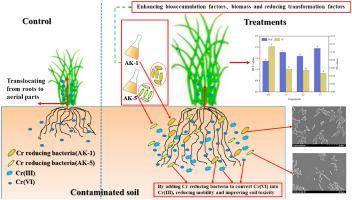Chemosphere ( IF 8.8 ) Pub Date : 2021-06-15 , DOI: 10.1016/j.chemosphere.2021.131186 He Peng 1 , Ke Liang 1 , Huanyan Luo 1 , Huayan Huang 1 , Shihua Luo 1 , AKang Zhang 1 , Heng Xu 2 , Fei Xu 2

|
Phytoremediation as an efficient and eco-friendly soil detoxification method has received widespread attention. In this study, two newly screened Chromium (Cr) reducing strains (Bacillus sp. AK-1 and Lysinibacillus sp. AK-5) were used to remediate Cr contaminated soil in conjunction with the application of hyperaccumulator tall fescue (Festuca arundinacea), thus establishing a soil Cr decontamination system. In this system, soil urease and dehydrogenase activities were increased, the malondialdehyde (MDA) contents in leaves of tall fescue were significantly decreased, while glutathione (GSH) contents increased. In terms of Cr fractions, the proportion of acetic acid extractable Cr decreased by 12.82–20.00% in treatment groups, respectively, compared with CK, while residual Cr increased by 9.41–22.37%. Moreover, biomass, root length and shoot length of tall fescue in treatment groups increased by 80.77–139.74%, 60.85–68.04%, 7.06–27.10%, respectively. In addition, the root system of tall fescue accumulated 303.887–372.167 mg kg−1 of Cr, and the aboveground part accumulated 16.289–19.289 mg kg−1 of Cr. Therefore, the application of strains AK-1 and AK-5 reduced the toxicity of Cr to plants and greatly increased plant accumulation potential, which indicated that AK-1 and AK-5 could improve removal efficiency of phytoremediation in Cr contaminated soil by reducing its bio-toxicity and promoting growth of tall fescue growth.
中文翻译:

芽孢杆菌属和赖氨酸杆菌属。用于快速净化受铬影响的土壤的生物增强型羊茅植物修复系统
植物修复作为一种高效、环保的土壤解毒方法受到了广泛关注。在本研究中,两种新筛选的铬 (Cr) 还原菌株(芽孢杆菌属 AK-1 和赖氨酸杆菌属AK-5)与超富集高羊茅(Festuca arundinacea)的应用相结合,用于修复受铬污染的土壤,从而建立土壤铬净化系统。在该系统中,土壤脲酶和脱氢酶活性增加,高羊茅叶片中丙二醛(MDA)含量显着降低,而谷胱甘肽(GSH)含量增加。在Cr组分方面,与CK相比,处理组中乙酸可提取Cr的比例分别降低了12.82-20.00%,而残留Cr增加了9.41-22.37%。此外,处理组高羊茅的生物量、根长和茎长分别增加了80.77-139.74%、60.85-68.04%、7.06-27.10%。此外,高羊茅根系积累了303.887-372.167 mg kg -1 Cr,地上部分积累了16.289-19.289 mg kg -1铬。因此,菌株AK-1和AK-5的应用降低了Cr对植物的毒性,并大大提高了植物的积累潜力,表明AK-1和AK-5可以通过降低Cr污染土壤中Cr污染土壤的去除效率来提高植物修复的去除效率。生物毒性和促进高羊茅生长的生长。



























 京公网安备 11010802027423号
京公网安备 11010802027423号